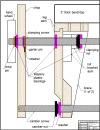This thread is a follow-on to
This project of mine is to develop a wooden face vise design for workbenches that only costs a few tens of dollars. Primary target audience is for woodworkers without a vise and those maybe without a lot of money for a vise.
The first prototype exposed a few problems. This thread picks up at the point of making a revised nut block. The nut block position is adjustable to set the screw perpendicularity and my next post will show how I milled the nut block.
This project of mine is to develop a wooden face vise design for workbenches that only costs a few tens of dollars. Primary target audience is for woodworkers without a vise and those maybe without a lot of money for a vise.
The first prototype exposed a few problems. This thread picks up at the point of making a revised nut block. The nut block position is adjustable to set the screw perpendicularity and my next post will show how I milled the nut block.
Last edited:

